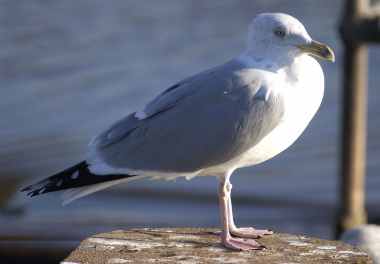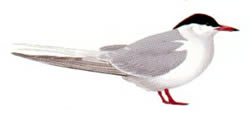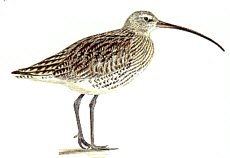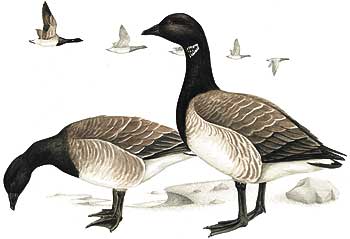|
 Oystercatcher Oystercatchers are common on the beaches except in mid-summer when breeding birds are at more remote areas. In winter they can be seen on the
shore greens and GAA pitch. They are easily recognized by their black and white plumage and bright orange bill.
Oystercatcher Oystercatchers are common on the beaches except in mid-summer when breeding birds are at more remote areas. In winter they can be seen on the
shore greens and GAA pitch. They are easily recognized by their black and white plumage and bright orange bill.
 Black Headed Gull This is the most common gull on Buncrana's beaches. In winter it looses the black on it's head, except for a small spot behind the eye, but can be
recognized by the white stripe along the front edge of the wing.
Black Headed Gull This is the most common gull on Buncrana's beaches. In winter it looses the black on it's head, except for a small spot behind the eye, but can be
recognized by the white stripe along the front edge of the wing.
 Common Gull About the same size as Black Headed. Despite it's name, it is not as common as the Black Headed Gull.
Common Gull About the same size as Black Headed. Despite it's name, it is not as common as the Black Headed Gull.
 Herring Gull Similar but larger than Common Gull.
Herring Gull Similar but larger than Common Gull.
 Great Black-backed Gull This is the largest gull and is easily recognised by the black back. It chases other sea birds
until they give up their food and can kill smaller birds.
Great Black-backed Gull This is the largest gull and is easily recognised by the black back. It chases other sea birds
until they give up their food and can kill smaller birds.
 Rock Pipit This little grey-brown bird is never far from the beach and is found all round Inishowen,s coast.
It is the only passerine ( perching ) bird that specializes in living on the shore. It makes it's nest in clefts in the rocks.
Rock Pipit This little grey-brown bird is never far from the beach and is found all round Inishowen,s coast.
It is the only passerine ( perching ) bird that specializes in living on the shore. It makes it's nest in clefts in the rocks.
Birds-Town & Gardens
Birds-River
Birds-Woodland & Farmland
Birds-Moorland
Birds around Buncrana Home
Quiz
|
 Common Tern Terns are summer visitors spending the winter along the coast of Africa.
They dive into the water from a height to catch sand eels. Terns nest on a small island at Inch Lake.
Common Tern Terns are summer visitors spending the winter along the coast of Africa.
They dive into the water from a height to catch sand eels. Terns nest on a small island at Inch Lake.
 Sandwich Tern Similar to Common Tern but larger. When seen close up it has a black crest on it's head.
Sandwich Tern Similar to Common Tern but larger. When seen close up it has a black crest on it's head.
 Cormorant The diving bird that you will see most often on Lough Swilly. They stay underwater for a few minutes to catch fish and eels.
Sometimes you can see it standing on a rock with wings outstretched to dry.
Cormorant The diving bird that you will see most often on Lough Swilly. They stay underwater for a few minutes to catch fish and eels.
Sometimes you can see it standing on a rock with wings outstretched to dry.
 Curlew This is the largest bird of the wader family. It uses it's long curved bill to probe the
sand and mud for food. The curlew is also a moorland bird but is most often seen on the beach especially around the estuary of the Crana
river
Curlew This is the largest bird of the wader family. It uses it's long curved bill to probe the
sand and mud for food. The curlew is also a moorland bird but is most often seen on the beach especially around the estuary of the Crana
river
 Redshank This is a smaller elegent wader that gets it's name from the colour of it's legs. It can sometimes be seen at the waters edge around
the mouth of the Crana.
Redshank This is a smaller elegent wader that gets it's name from the colour of it's legs. It can sometimes be seen at the waters edge around
the mouth of the Crana.
 Brent Goose There is usually a small flock of these geese on one of Buncrana's beaches during the winter.
They spend the summer in Canadian Arctic regions. Much larger flocks of wild geese come to Inch Lake and Trawbreaga Bay.
Brent Goose There is usually a small flock of these geese on one of Buncrana's beaches during the winter.
They spend the summer in Canadian Arctic regions. Much larger flocks of wild geese come to Inch Lake and Trawbreaga Bay.
Inishowen Home
|
























